Great Depression Test Questions – Flashcards
Unlock all answers in this set
Unlock answersquestion
(1929-1941) The dramatic decline in the world's economy however not due to the United State's stock market crash of October 1929, (1929-1939) The dramatic decline in the world's economy due to the United State's stock market crash of 1929, the overproduction of goods from World War I, and decline in the need for raw materials from non industrialized nations. Results in millions of people losing their jobs as banks and businesses closed around the world. Many people were reduced to homelessness, and had to rely on government sponsored soup kitchens to eat. World trade also declined as many countries imposed protective tariffs in an attempt to restore their economies. Causes of_________ were overproduction, Underconsumption, stock market speculation
answer
GREAT DEPRESSION
question
It caused Americans to lose confident and decreased stock investments.
answer
1. How did the stock market crash affect America?
question
-buying things on credit direct cause -stock crash indirect cause.
answer
2. What factors contributed to the Great Depression?
question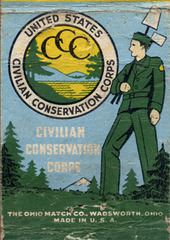
CCC Hired young, unemployed people to do restoration projects throughout the country, employed over 3 million people. Relief: (CCC) March 31, 1933; reduced poverty/unemployment, helped young men and families; young men go to rural camps for 6 months to do construction work; $1/day; intended to help youth escape cities; concerned with soil erosion, state/national parks, telephone/power lines; 40 hr weeks

answer
Civilian Conservation Corps
question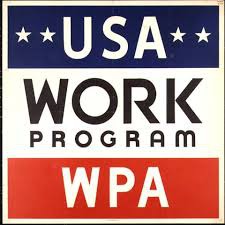
WPA The Works Progress Administration (renamed in 1939 as the Work Projects Administration; WPA) was the largest and most ambitious American New Deal agency, employing millions of unemployed people (mostly unskilled men) to carry out public works projects, including the construction of public buildings and roads. New Deal agency that helped create jobs for those that needed them. It created around 9 million jobs working on bridges, roads, and buildings. May 6, 1935- Began under Hoover and continued under Roosevelt but was headed by Harry L. Hopkins. Provided jobs and income to the unemplyed but couldn't work more than 30 hours a week. It built many public buildings and roads, and as well operated a large arts project.

answer
Works Progress administration WPA
question
NRA Government agency that was part of the New Deal and dealt with the industrial sector of the economy. It allowed industries to create fair competition which were intended to reduce destructive competition and to help workers by setting minimum wages and maximum weekly hours. The most ambitious attempt to control and plan the economy was the National Recovery Administration (NRA), established by Congress right after Roosevelt took office. The key idea behind the NRA was to reduce competition and fix prices and wages for everyone's benefit, along with sponsoring enough public works projects to ensure recovery. The NRA's goal required government, business, and labor to hammer out detailed regulations for each industry. Because NRA broke with the cherished American tradition of free competition and aroused conflicts among business people, consumers, and bureaucrats, it was not a success and the NRA was declared unconstitutional by the supreme court.
answer
National Recovery Administation
question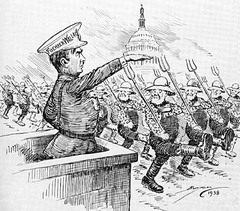
AAA (FDR) 1933 and 1938 , Helped farmers meet mortgages. Unconstitutional because the government was paying the farmers to waste 1/3 of there products. Created by Congress in 1933 as part of the New Deal this agency attempted to restrict agricultural production by paying farmers subsidies to take land out of production. Recovery: (AAA); May 12, 1933; restricted crop production to reduce crop surplus; goal was to reduce surplus to raise value of crops; farmers paid subsidies by federal government; declared unconstitutional by the Supreme Court in US vs Butler on January 6, 1936

answer
Agricultural Adjustment act
question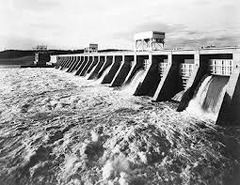
TVA A relief, recovery, and reform effort that gave 2.5 million poor citizens jobs and land. It brought cheap electric power, low-cost housing, cheap nitrates, and the restoration of eroded soil. A relief, recovery, and reform effort that gave 2.5 million poor citizens jobs and land. It brought cheap electric power, low-cost housing, cheap nitrates, and the restoration of eroded soil.

answer
Tennessee valley Authority
question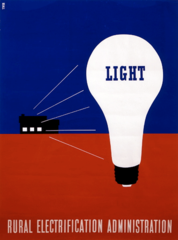
REA 1935; made electricity available at low rates to American farm families in areas that private power companies refused to service. Part of FDR's "Second New Deal" programs; brought affordable electricity to isolated rural areas

answer
Rural Electrification administration
question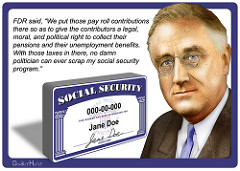
(FDR) 1935, guaranteed retirement payments for enrolled workers beginning at age 65; set up federal-state system of unemployment insurance and care for dependent mothers and children, the handicapped, and public health A 1935 law passed during the Great Depression that was intended to provide a minimal level of sustenance to older Americans and thus save them from poverty.

answer
Social Security
question
The New Deal
answer
3b. What economic reforms were aimed at preventing another depression?
question
FDIC (FDI) A United States government corporation created by the Glass-Steagall Act of 1933. It provides deposit insurance, which guarantees the safety of deposits in member banks, currently up to $250,000 per depositor per bank Gave insurance to banks an agency created in 1933 to insure individuals' bank accounts, protecting people against losses due to bank failures
answer
Federal Deposit Insurance Coperation
question
See Securities Act of 1933. Required promoters to transmit to the investor sworn information regarding the soundness of their stocks and bonds A federal piece of legislation enacted as a result of the market crash of 1929. The legislation had two main goals: (1) to ensure more transparency in financial statements so investors can make informed decisions about investments, and (2) to establish laws against misrepresentation and fraudulent activities in the securities markets.
answer
Trust in Securities act
question
A 1935 law, also known as the Wagner Act, that guarantees workers the right of collective bargaining sets down rules to protect unions and organizers, and created the National Labor Relations Board to regulate labor-managment relations. (FDR) A 1935 law, also known as the Wagner Act, that guarantees workers the right of collective bargaining sets down rules to protect unions and organizers, and created the National Labor Relations Board to regulate labor-managment relations. *, Made sure workers were treated and payed well and not getting abused by their business. *this law created the National Labor Relations Board to enforce the law and supervise shop elections
answer
National labor Relations
question
Many New Deal programs remain active, with some still operating under the original names, including the Federal Deposit Insurance Corporation (FDIC), the Federal Crop Insurance Corporation (FCIC), the Federal Housing Administration (FHA), and the Tennessee Valley Authority (TVA).
answer
5. What parts of the New Deal are still in effect today?
question
some apposed the new deal and also Fdr wanted to appoint 6 more justices.
answer
6. What role did the Supreme Court play during the Great Depression?
question
They where unemployment and lost homes and money. Also after the new deal their communities where fixed and improved.
answer
7. What effects did the Great Depression have on women, families, and communities?
question
The president shared policy snd communicated with the people. Also they also did that to take away their time.
answer
8. How did radio, music, sports, and movies help people take their minds off the Great Depression?
question
They had the same as the 20 only more fur.
answer
9. What were some fads and fashions of the 1930's?
question
She was the first active First Lady. She was an impotent aspect of Franklin Roosevelt decisions. She shared her perspective on decisions and make a political career.
answer
10. What role did Eleanor Roosevelt play in "helping" FDR during the Great Depression?
question
"During the depths of the Great Depression of the 1930s and into the early years of World War II, the Federal government supported the arts in unprecedented ways. For 11 years, between 1933 and 1943, federal tax dollars employed artists, musicians, actors, writers, photographers, and dancers. Never before or since has our government so extensively sponsored the arts. MORE... Fishermans Village Rediscovering America Celebrating the country's past and its character promoted a sense of national identity during a difficult time and yielded art that people could understand and appreciate. The Riveter Celebrating "the People" Visual artists, writers, filmmakers, and playwrights concentrated many of their creative efforts on the patterns of everyday life, especially the world of work. A recurring theme was the strength and dignity of common men and women, even as they faced difficult circumstances. Work Pays Work Pays America Most New Deal artists were grateful to President Roosevelt for giving them work and enthusiastically supported the New Deal's liberal agenda. Not surprisingly, their art celebrated the progress made under Franklin Roosevelt and promoted the President and his programs. Activists Arts Activist Arts Many politically active artists worked for the New Deal projects. United by a desire to use art to promote social change, these artists sympathized with the labor movement and exhibited an affinity for left-wing politics ranging from New Deal liberalism to socialism to communism. Useful Art Useful Arts Most New Deal artist-administrators believed deeply that the projects had a responsibility to reach out to as many Americans as possible and to put art to practical use. Such socially useful arts were not intended to create masterpieces, but they did produce many excellent works, allowed thousands of artists to pursue their vocation, and enriched and informed the lives of Americans." (National Archives and Records Administration).
answer
11. How were art, literature, and photography influenced by the Great Depression?
question
(1929-1933) The New York Stock Market Crashes October 29, 1929 "Black Tuesday". The 20th Amendment is passed and added and the 21st Amendment is passed by 1933.
answer
Herbert Hoover
question
Shanty towns that the unemployed built in the cities during the early years of the Depression; the name given to them shows that the people blamed Hoover directly for the Depression. The shantytowns were made from scrap material, wood, metal, etc. Homeless people lived in these during the depression.
answer
Hoovervilles
question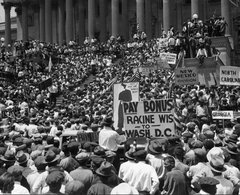
Group of WWI vets. that marched to D.C. in 1932 to demand the immediate payment of their goverment war bonuses in cash. 1932 - Facing the financial crisis of the Depression, WW I veterans tried to pressure Congress to pay them their retirement bonuses early. Congress considered a bill authorizing immediate assurance of $2.4 billion, but it was not approved. Angry veterans marched on Washington, D.C., and Hoover called in the army to get the veterans out of there. Camped along the Potomac River. 20,000 jobless.

answer
Bonus Army
question
to fail to pay a debt or to perform a task. A legal procedure whereby property used as security for a debt is sold to satisfy the debt in the event of default in payment of the mortgage note or default of other terms in the note.
answer
Default/foreclosure
question
A long-term economic state characterized by unemployment and low prices and low levels of trade and investment and a period of low economic activity and rising unemployment
answer
Depression
question
Government practice of spending more than it takes in from taxes. government spending, in excess of revenue, of funds raised by borrowing rather than from taxation.
answer
Deficit spending
question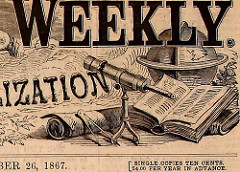
..., Means to over "guess." The majority of the people felt the stock market will go up, so they greedily buy, when in reality it's the peak already and stock market prices will drop soon. Many investors taking risk in business in order to make a profit but it ends up hurting the economy,

answer
Overspeculation
question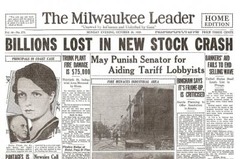
October 29, 1929. Signaled the Financial collapse of the nation. 1929. On this date, share prices on the New York Stock Exchange completely collapsed, becoming a pivotal factor in the emergence of the Great Depression. raised stock -no buyer- stock drop -great depression

answer
Black Tuesday
question
A general increase in prices and fall in the purchasing value of money.
answer
Inflation
question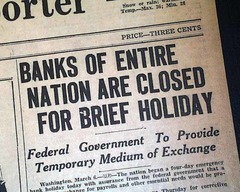
All the banks were ordered to close until new laws could be passed. An emergency banking law was rushed through Congress. The Law set up new ways for the federal government to funnel money to troubled banks It also required the Treasury Department to inspect banks before they could re-open. FDR closes all American banks for 4 days (Congress meets to discuss legislation); Creates a great sense of relief for the public

answer
Bank Holiday
question
32nd President of the United States. 1933-1945, Democrat, "forgotten man," broke two term rule, platform - prohibition, help farmers, prevent fraud, balanced budget, decrease public spending, third election - two groups: "Defend America by Aiding the Allies" and "America First". Democrat; New Deal to end great depression (created an "alphabetocracy" of agencies): two parts: First 100 Days and 2nd New Deal; social security created under the New Deal, opposition from Supreme Court, so he tried "court packing" (people didn't like that), tried to maintain neutrality in WWII, but had ties to allies (Lend Lease Act, strong economic ties), 1941: Pearl harbor ("a date which will live in infamy"), US enters WWII, died in 1945 while in office
answer
Franklin Roosevelt
question
informal talks given by FDR over the radio; sat by White House fireplace; gained the confidence of the people. During the depression years of the 1930s, President Roosevelt used the radio to communicate with the American people, using plain language to explain complex issues and programs. These had a reassuring and steadying effect on the public and boosted confidence. President F. Roosevelt's use of radio broadcasts to connect him and the people in an intimate way. Through these, he explained the nature of the bank moratorium, farm relief, and his New Deal's alphabet agencies to solve problems of the Depression.
answer
Fireside chats
question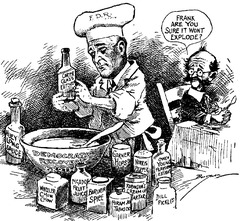
Group of expert policy advisers who worked with FDR in the 1930s to end the great depression FDR's "inner circle" of selected experts rather than typical politicians or businessmen A group of university professors Roosevelt turned to. It included Rexford Tugwell, Raymond Moley, and Adolph A. Berle Jr.

answer
The Hundred Days/Brain Trust
question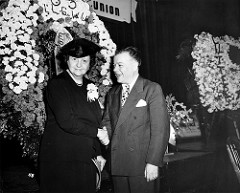
(born Fanny Coralie Perkins, lived April 10, 1882 - May 14, 1965) was the U.S. Secretary of Labor from 1933 to 1945, and the first woman ever appointed to the cabinet. As a loyal supporter of her friend Franklin D. Roosevelt, she helped pull the labor movement into the New Deal coalition. Roosevelt's secretary of labor (1993-1945); she had a great influence on many New Deal programs, most significantly the Social Security Act.

answer
Frances Perkins
question
(FDR) 1935, guaranteed retirement payments for enrolled workers beginning at age 65; set up federal-state system of unemployment insurance and care for dependent mothers and children, the handicapped, and public health A combination of entitlement programs, paid for by employer and employee taxes, that includes retirement benefits, health insurance, and support for disabled workers and the children of deceased or disabled workers.

answer
Social Security
question
Parts of Oklahoma, Kansas, Colorado, New Mexico, and Texas that were hit hard by dry topsoil and high winds that created blinding dust storms; this area of the Great Plains became called that because winds blew away crops and farms, and blew dust from Oklahoma to Albany, New York. Ruined farms and left many farmers with out crops and money. that experienced a drought in 1930 lasting for a decade, leaving many farmers without work or substantial wages. Long periods of drought and destructive farming methods ruined farming in the region,
answer
Dust Bowl
question
Displaced farm families from the Oklahoma dust bowl who migrated to California during the 1930s in search of jobs.
answer
Okies
question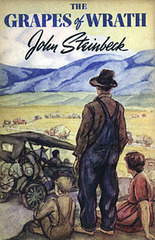
The story follows the fortunes of a poor family as they travel from the Dust Bowl region to California. based on the great depression written by John Steinbeck John Steinbeck's novel about a struggling farm family during the Great Depression. Gave a face to the violence and exploitation that migrant farm workers faced in America. Featured information about the Dust Bowl. Also talked about by FDR wife.

answer
The Grapes of Wrath
question
An economic and governmental system based on public ownership of the means of production and exchange.
answer
Socialism
question
a sum of money granted by the government or a public body to assist an industry or business so that the price of a commodity or service may remain low or competitive.
answer
Subsidies
question
To buy stock by paying only a fraction of the stock price and borrowing the rest
answer
on margin



